Our patterns and function machines worksheets are the best on the internet for helping students understand these important math concepts. These worksheets are free to download and print, making them a convenient and budget-friendly resource for teachers and homeschooling parents. Our patterns and function machines worksheets cover a wide range of skills, including identifying and extending patterns, evaluating function machines, and solving word problems involving patterns and functions. With our patterns and function machines worksheets, students will have the opportunity to practice and apply their skills in a variety of contexts, reinforcing their understanding of these concepts.
Browse Sheets By Problem Type
×
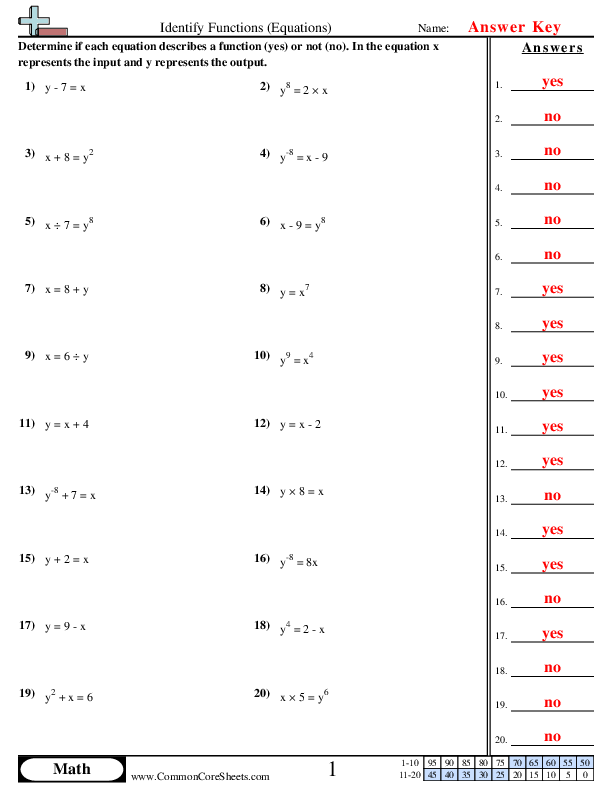
Identify Functions (Equations)
8f1


×
Description:
"This worksheet is designed to enhance children's understanding of mathematical functions, specifically equations. It contains 20 math problems asking to identify functions presented in different formats. Ideal for distance learning, the worksheet's content can also be customized or converted into flash cards to facilitate enjoyable practice. The varying complexity of the problems ensures solid mastery of the topic."

×
Student Goals:
Problem Solving SkillsUpon completion of the worksheet, students will have significantly improved their problem solving abilities. They will be able to accurately identify and analyze mathematical functions, strengthening their ability to understand and categorize different equations. This ability fosters a precision-based approach to math, promoting intellectual flexibility and adaptive reasoning.Mathematical LiteracyStudents will improve their overall mathematical literacy, more specifically in understanding functions. Decoding equations, grasively other mathematical concepts. This broadened understanding can stimulate logical thinking, supporting effective decision-making, and problem-solving across various facets of life.Critical ThinkingProper comprehension of mathematical equations requires critical thinking - a skill that children can significantly enhance by accomplishing this worksheet. It will enable them to strategically approach problems by recognizing patterns, understanding relationships between variables, and deducing the behavior of mathematical functions.Conceptual UnderstandingThis worksheet helps to strengthen students' conceptual understanding of equations and basic math operations. They will get familiarized with variable expressions, constants, and their interrelationships, providing an excellent foundation for more intricate concepts in higher-level mathematics.Application SkillsCompleting the worksheet will enable students to apply their knowledge to real-world scenarios. As they get acquainted with different mathematical functions, they can better quantify and model various real-world phenomena and problems, thereby translating abstract concepts into practical applications.Accelerated LearningThe worksheet is designed to enhance students' mathematical proficiency in a stress-free environment, which can accelerate their learning. By solving the problems, the students will be enabling cognitive connections to multiple math concepts. This can trigger lasting understanding and ease math anxiety, creating a positive mindset towards learning.Preparation for Advanced TopicsBy mastering the functions and equations in this worksheet, students will be well-prepared to tackle more advanced topics. This understanding forms a strong foundation for algebra, calculus and other advanced study areas. It also serves as a springboard into more complex mathematical theories, thereby fostering interest in such topics and enhancing college and career readiness.


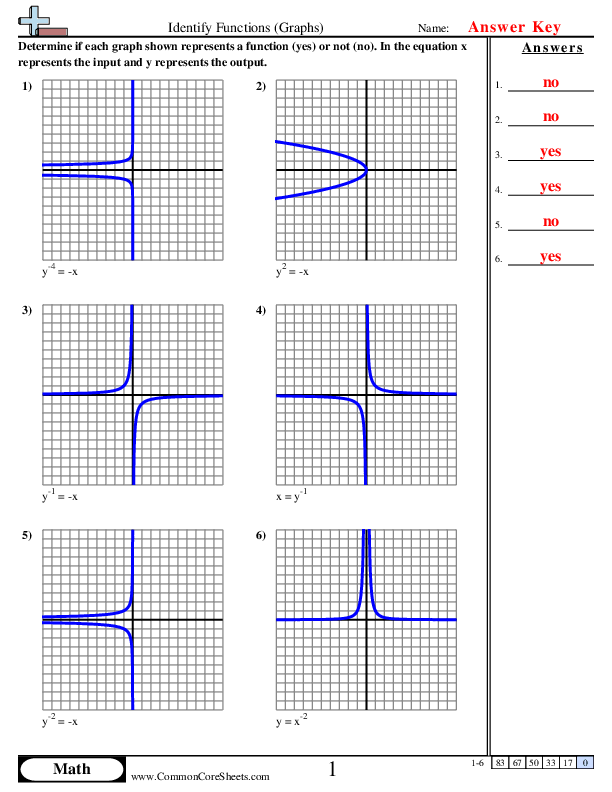
Identify Functions (Graphs)
8f1


×
Description:
"This worksheet is designed to help children identify functions in mathematical graphs. It features six problems which challenge young minds to interpret equation-based graphs such as y-1 = -x, -y = x1, and others. Besides, it can be customized to meet specific learning needs, be easily converted into flash cards for interactive learning, or be used in a distance learning context to reinforce mathematical concepts."

×
Student Goals:
Understanding of Graphical FunctionsUpon completion of the worksheet, students should develop a deeper understanding and ability to interpret and identify functions represented graphically. This ability is pivotal in mathematics, which forms an integral part of problem-solving in various disciplines from physical to social sciences.Problem Solving and Analytical SkillsThe worksheet will help students to enhance their analytical skills in mathematics. Every problem in the worksheet requires students to apply their knowledge to solve the problems independently, thereby strengthening their logical thinking and problem-solving abilities.Master Different Forms of FunctionsStudents will learn to work with different forms of functions through this worksheet. They will become proficient in recognizing various types of functions like polynomial, linear, cubic, quadratic, and inverse relations, thus widening their understanding of the diverse nature of mathematical functions.Interpretation of Algebraic EquationsStudents will practice interpreting and transcribing algebraic equations, a skill essential to many areas of mathematics. The visual understanding of equations fosters mathematical fluency and contributes to the overall comprehension of algebra.Translating GraphsStudents will learn how to accurately translate numerical information into graphical form, enhancing their skill of visual representation of mathematical data. The ability to graph equations allows students to visualize relationships between different sets of numbers.Confidence in Mathematical ProficiencyThe successful completion of this worksheet aids in fostering confidence in mathematical proficiency. This will encourage students to take on more challenging tasks, participating actively in classroom activities, and develop an inclination towards the subject leading to future academic success in the field.



Identifying Functions (Tables)
8f1


×
Description:
"This worksheet is designed to instruct children in mathematical functions using tables. It employs 15 distinct puzzles, where X and Y values interrelate, teaching essential numbering concepts. Offering customizability, it can be seamlessly adapted into flash cards or integrated into a distance learning curriculum, enhancing the learning experience and reinforcing critical math skills."

×
Student Goals:
Mathematical understandingAfter completing this worksheet, students should have developed a deeper understanding of functions and how they correspond to tables. They should be able to proficiently read, understand, and interpret data from tables. Moreover, they should be familiarized with the concept of XY table and how changes in one variable (X) can affect another variable (Y).Problem-solving skillsThis exercise will equip students with essential problem-solving skills as they would have encountered and worked through a variety of unique problems. Working with 15 different mathematical problems helps to cultivate flexibility and tenacity in problem-solving, as they are required to identify patterns and apply logic to solve problems.Analytical skillsStudents should acquire analytical skills that are quintessential in mathematics and science subjects. They should be more adept at identifying patterns, discerning relationships between variables (XY pairs), and predicting outcomes based on certain trends. This worksheet will have shaped better analytical thinkers who can analyze, evaluate, and synthesize information effectively.Critical ThinkingBy solving these function problems, students will boost their critical thinking skills. They should be more competent at identifying relationships, making assumptions, and reaching conclusions based on information presented in tables. Such skills are invaluable for more advanced mathematical concepts.Mastery of Mathematical ConceptsAfter completing the worksheet, the students should master how to identify different types of functions from a table. They will understand the correlation between two numbers in an XY pair and how changes in X affect Y. This mastery of basic mathematical concepts will serve as a strong foundation for understanding more complex math theories in future.


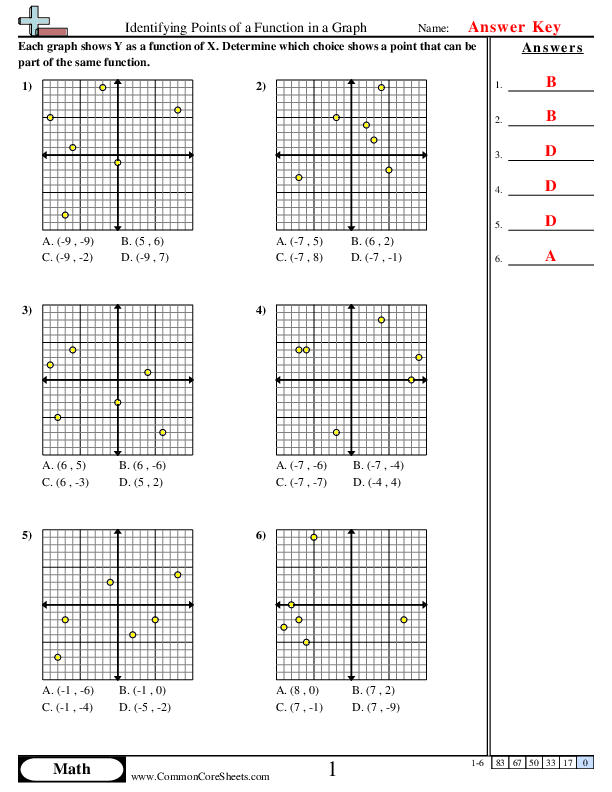
Identifying Points of a Function in a Graph
8f1


×
Description:
"This worksheet is designed to help children understand the concept of identifying points of a function in a graph within the subject of math. Featuring six problems with varying coordinates, it promotes problem-solving and analytical thinking. The worksheet can be customized to suit individual learning styles, easily converted into flashcards, and is ideal for distance learning situations."

×
Student Goals:
Skill DevelopmentAfter completing the worksheet, students will have honed their skills in identifying points of a function in a graph. They will have a better understanding of the Cartesian coordinate system, be able to interpret coordinates, and understand their relationship with graphs. In the process, they improve their mathematical reasoning and analytical thinking skills.Application of KnowledgeThe students will further be able to apply this knowledge in solving more complex mathematical problems. They will be equipped to analyze graphs more accurately, identify patterns, and understand how changes in numbers can affect the position of points in the plot. This knowledge is not only applicable in studying functions but also extends to areas like physics and engineering.Critical ThinkingThe worksheet tasks will stimulate the students' critical thinking abilities. By identifying points of a function, students learn to solve problems logically and systematically. It fosters their ability to think critically by interpreting and analyzing graphical data.Preparation for Future ConceptsMoreover, the acquired skills will prepare students for more advanced mathematical concepts such as interpreting complex functions, solving for unknown variables, implementing mathematical models and integrating different mathematical methods.Boosting ConfidenceSuccessfully understanding and completing this worksheet can significantly boost students' confidence, fostering a positive and proactive attitude towards learning math. It validates their ability to understand complex concepts and can ignite a passion for learning more about the subject.Building a Solid FoundationHandling such exercises enhances the arithmetic and algebra skills of the students, thus cementing their foundation in math. They will have a greater capacity to visualize mathematical problems, building a robust platform for further learning in advance mathematics, and other disciplines that require knowledge of mathematical relationships.


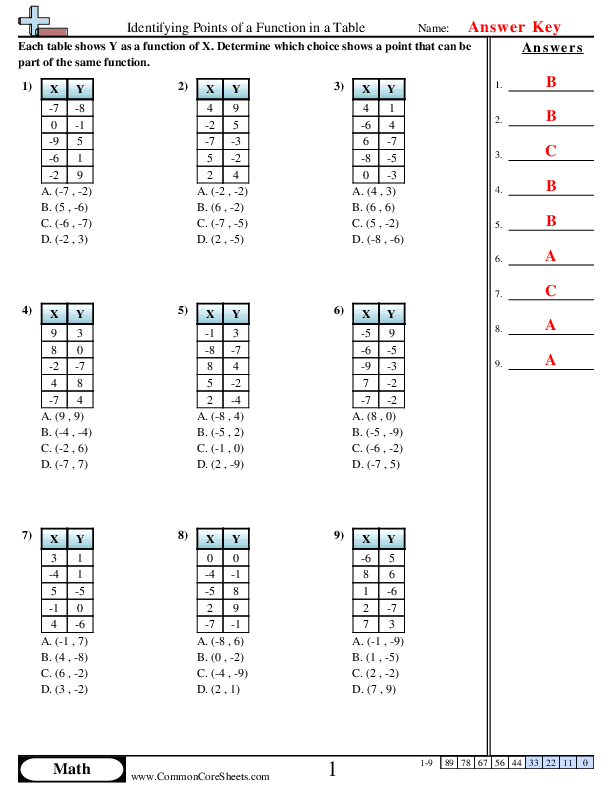
Identifying Points of a Function in a Table
8f1


×
Description:
"This worksheet is designed to reinforce children's understanding of identifying points on a function within a table. Through engaging math problems, learners will explore key concepts related to the coordinate plane. Featuring nine customisable problems that can be converted into flashcards or utilized in distance learning, it offers a dynamic and adaptive resource to aid their mathematical development."

×
Student Goals:
Function IdentificationAfter successfully completing this worksheet, students will have thoroughly familiarized themselves with identifying points of a function in a table. This fundamental mathematical operation plays a vital role in the world of mathematics, and understanding it opens the door to a wide scope of related topics. The operation itself requires an understanding of function as a cornerstone of mathematics, experimental skills in matching pairs and keen attention to detail.Critical Thinking EnhancementThe worksheet tasks are carefully curated to ensure students develop critical thinking skills. Any mathematical operation requires strategic reasoning and thoughtful problem-solving. The ability to make accurate deductions and decisions is a critical character trait that students will improve on upon completion of the worksheet. They will be able to execute better reasoning skills to solve real-life problems even outside the classroom.Enhancement of Computational SkillsIn addition to understanding the key concept of function identification, this worksheet also aids in honing the students' computational skills. Computing and coordinating XY values is a skill that needs practice, and this worksheet provides the perfect opportunity to perform and perfect these computations. It allows an excellent platform for students to learn and practice solving problems using a systematic approach that can be applied universally.Understanding Mathematical LanguageThrough this worksheet, students will gain a comprehensive understanding of the language of mathematics and the ability to translate it into understandable terms. The exercise in distinguishing relationships between variables contributes to a broader understanding of the patterns and principles constituting the mathematical universe.Increased ConfidenceFinally, throughout this worksheet, students will build confidence in their math skills. As they work through each problem and learn to identify the correct points on the function table, they will also be reinforcing their math base. This assurance can generate a positive attitude towards math and other similar tasks, resulting in an overall academic improvement. Confidence in their ability to surmount challenges gives them the momentum to tackle more complex equations with enthusiasm and tenacity.


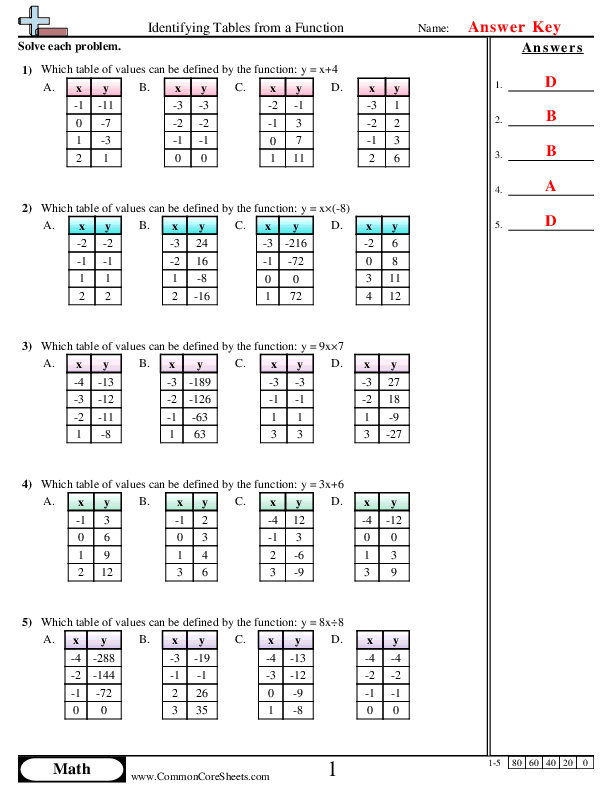
Identifying Tables from a Function
8f1


×
Description:
"This worksheet is designed to enhance children's understanding of mathematical functions. Its interactive examples will prompt learners to identify value tables defined by simple equations, sharpening skills in problem-solving and basic algebra. With five different problems to solve, the content provides an engaging way of reinforcing knowledge. The worksheet's versatile nature allows customization, conversion into flashcards for quick learning, or integration into distance learning programs, making math practice more effective and flexible."

×
Student Goals:
Strengthened Understanding of Basic Mathematical FunctionsWith the completion of this worksheet, students will have a more profound comprehension of primary mathematical functions. They will be well-versed with visually identifying and interpreting tables from a function which is a foundational skill in algebraic mathematics. The worksheet supports the reinforcement of knowledge about different types of functions and how the variables interact in each function.Sharpened Problem-Solving SkillsThe worksheet is designed to test students understanding thus improving their mathematical problem-solving skills. They will be able to solve complex problems that involve deriving a table of values from given functions. This critical skill not only is applicable in advanced mathematical engagements but also in real-world situations that involve data interpretation.Augmented Analytical AbilitiesBy successfully identifying tables from a function, students will enhance their analytical abilities. This worksheet allows learners to analyze various functions and match them with the correct tables of values. Hence, this pushes students to think analytically and logically, which extends beyond mathematics to daily life situations.Improved Conceptual KnowledgeWith the help of this worksheet, students will gain improved conceptual knowledge about mathematical functions. Understanding the abstraction of functions and how they map to concrete values is an invaluable skill in advanced mathematics. Students will be able to visualize different scenarios where given functions can apply, further deepening their conceptual understanding of math topics.Boost Confidence in MathematicsSuccessfully completing this worksheet will boost students confidence in their mathematical abilities. As the students identify tables from a function, they will become more confident in using functions to identify values and vice versa. This increased self-confidence can lead to better results in future mathematical tasks and contributes to a positive perception of one's mathematical abilities.







